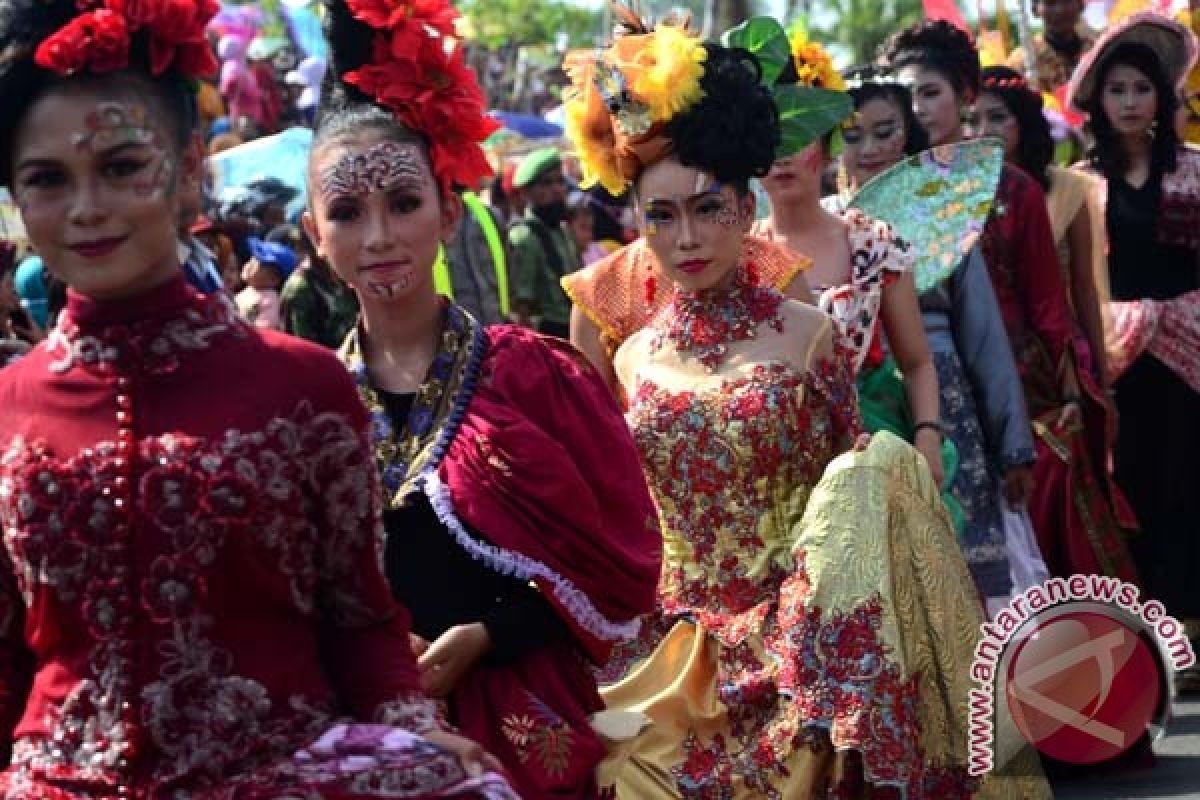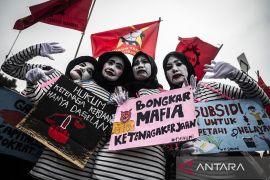They call it Salem Batik instead of Brebes Batik."Jakarta (ANTARA News) - "It must be somewhere around here. Give me some time (to find it)...," Tuti Wirjadigjaja, a 59-year-old housewife, said as she opened the door of a two-meter tall cabinet in her room.
Inside the cabinet were all her precious batiks -- the Indonesian traditional clothes painted by using wax-resistant dyeing technique, including two pieces of Brebes Batik that she had bought a few years ago.
The United Nations Educational, Scientific and Cultural Organization (UNESCO), in October 2009, inscribed Indonesian batik as a Masterpiece of Oral and Intangible Heritage of Humanity.
Most people associate Brebes, a district in the northwestern part of Central Java Province, with many things, from salted duck egg, shallot, blengong satay to peuyeum ketan, but not batik. Not many people know that Brebes has its own batik-design.
"I bought these from a boutique in Pekalongan which has a corner specially selling batiks from Brebes and other districts in Central Java," she explained.
Finally, after rummaging extensively for almost half an hour, she found one of them.
"They call it Salem Batik instead of Brebes Batik. This is gringsing design, a very old Javanese pattern on black and white palette that is not common for coastal batik," she said while showing her black and white Brebes Batik.
Black and white palette is a traditional color scheme for Jogja Batik. The coastal batik artisans usually tend to use more vibrant colors in their works.
"I expected yellow, blue and pink for coastal batik but when I had spoken to the artist back then, she had said this was the conservative Salem-design," she explained.
She refuses to be called a batik collector but keeps more than 150 batiks in the form of "kain panjang" (literally means "long fabric") in her closet. Traditionally, batik is sold in 2 1/4 meter lengths used for "kain panjang" which is part of Indonesian traditional dress.
In her own words, she is an accidental-batik collector. "I am not a collector. Although it looks like it, it is not intentional," she explained.
Batik is a part of "kebaya" dress, a traditional gown for Indonesian women. And as a Javanese wife, Tuti should wear kebaya to many formal events as she accompanies her husband, a retired government officer.
"A collector should know the story about each design. The only reason I buy batiks is because they look pretty, not because of their history, price or uniqueness," she said with a smile.
Tuti got her first batik around 40 years ago from her mother in-law. "It was a wedding gift. It was a set of old Javanese-Batik."
If Tuti refused to be called a collector, C. Kusumanintya, 30, an online batik reseller, said she wants to be someone who helps in the preservation of the old batik-designs.
"It would be nice to have every piece of Indonesian batik-design but there are thousands. So I mostly collect all those old-designs that catch my attention," she said.
Having some 50 pieces of batik, she said she had never heard of Brebes Batik before. "However, batik is very popular currently. Almost every region in this country has its own batik now. I even have a batik from Papua and Flores although these are relatively new. So I am not surprised if Brebes also has its own batik. Most regions in Java did follow the old tradition in batik-making."
Kusumanintya is right. Although it is not as well known as the batik from Jogja, Solo, Pekalongan or Cirebon, the batik from Brebes actually has a long history dating back to the 19th century.
Brebes Batik is made in Bentar and Bertarsari villages in Salem District, so these are also known as Salem Batik. Nobody is sure of when exactly the Brebes Batik was created but the batik-making skills have developed particularly well over tens of years in Bentar and Bentarsari villages.
Various sources, including the local governments website, mentioned at least three oral tales about the Bentar and Bentarsari villagers skills in batik-making.
Most local artisans believe that a daughter of a high ranking officer in Pekalongan, who had traveled to Bentar village, brought along the batik-making tradition when she married a local man in the 19th century.
As a result, the traditional Brebes Batik has indigenous patterns that are similar to Pekalongans patterns, such as "kopi pecah", "manggar", "merak", "gringsing" and "ukel kangkung."
According to the Brebes Industrial and Trade Office, those villages have more than 200 batik artisans now.
There is another story as per which the traders had brought batik to Brebes. The traders from Pekalongan had migrated to Salem District during a revolution back in the 19th century, and settled there since.
Many also believe that the journey of Brebes District Head Raden Arya Tjandranegara in November 1882 had led to the development and promotion of the batik-making skills among the local community.
Distinguished pattern
The origin of batik can easily be determined through its design as each region has its own traditional patterns. Some of the designs, mainly the royal batiks, have symbolic meanings.
In general, there are two types of batikpatterns --- inland batik and coastal batik. However, the indigenous Brebes Batik designs belong to inland batiks although Brebes is a coastal area.
This fact alone had prompted the assumption that the fleeing royals from Jogja and Solo might have brought batik-making skills to not only Brebes District but also several other regions in Central Java, such as Banyumas and Tegal, which also have a long tradition of batik-making.
Brebes Batik designs are dominated by the earthy-colors, such as black, white and "sogan" (brown-yellow color), similar to Yogyakarta Batik. However, its designs previously had been influenced by Pekalongan Batik, mainly the "buketan" (flower-bouquets) pattern.
However, at the turn of the 21st century, when batik had become a fashion item and could be seen on shirts, dresses, footwears and bags, Brebes Batik artisans developed several new designs which were inspired by the living culture of the Brebes people, such as salted duck egg and shallot patterns.
The new designs complimented the three classic designs, namely "kopi pecah", "manggar" and "gringsing."
A Batik artisan organization from Bantul, Jogja, the Sekar Arum Giriloyo on its website explained the meaning of those designs.
The "kopi pecah" (broken coffee grains) design, which features the shape of intersecting coffee grains bouquets, emphasizes the balance of physical and spiritual worlds.
While the "manggar" design, which is inspired by coconut flower (manggar in Javanese), will bless the wearer with the power to share kindness.
The "Gringsing" design, which features a circles pattern with a dot in the center, symbolizes balance, prosperity and fertility.
Although batik is also found in other countries, for centuries Indonesia, mainly Java, has been best known for batik-making art.
For centuries, Batik has been inseparable from the Indonesian culture.
Nowadays, men wear batik to formal events instead of a suit and a tie. President Joko Widodo, who grew up in Solo, once even claimed that he owned more than 200 batik shirts while the First Lady, Iriana Joko Widodo, actively introduced batiks to her counter parts at every opportunity.
In line with the First Ladys appeal to promote batik, the Brebes administration successfully held a Brebes Batik Exhibition in Singapore in September 2015 in an effort to boost the popularity of the local batiks, the Brebes government said on its official website.
Thanks to its uniqueness, it is about time the Brebes Batik flourished and found its place among the distinguished coastal batiks arts in this country.
(T. G003/F001/INE/KR-BSR/A014)
Reporter: Gusti Nur Cahyani
Editor: Priyambodo RH
Copyright © ANTARA 2016












